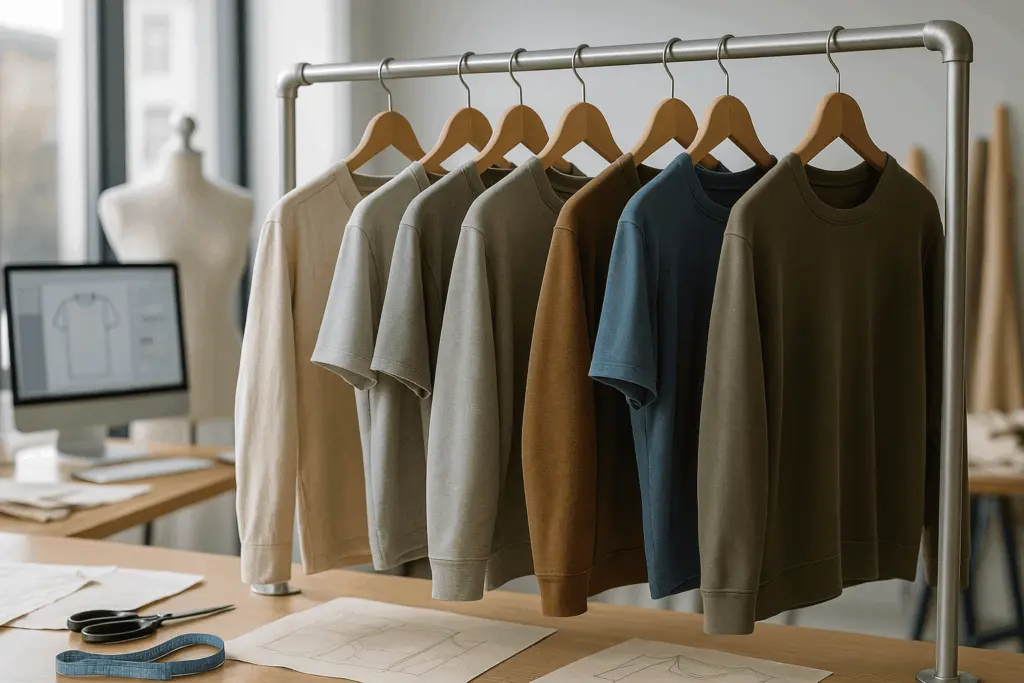
1. Introduction: What Is the Product Life Cycle in Fashion?
The product life cycle in fashion represents the full journey of an item — from concept and design to its final disposal or recycling. It covers the introduction phase, including market introduction and the product’s launch as a key milestone, followed by the growth stage, maturity stage, and decline stage. Each stage influences how a product performs in the market and how long it remains relevant to consumers. Understanding the product’s lifecycle is essential for developing a comprehensive marketing strategy that balances creativity, sustainability, and profitability.
Fashion products evolve fast. Consumer preferences change rapidly, pushing brands to constantly introduce new collections. However, before launching a new product, brands must assess whether it is potentially profitable. This fast pace contributes to massive waste, overproduction, and unsustainable business practices. Modern brands must now think beyond immediate trends and embrace a circular mindset that values durability and reusability.
This is where Product Lifecycle Management (PLM) comes in. PLM integrates all product data, from material sourcing to sales, creating a single source of truth for designers, manufacturers, and marketers. It brings together business processes such as marketing, manufacturing, R&D, and customer feedback to ensure a smooth and cohesive product development and management cycle. PLM also supports data quality for better decision-making. It ensures better communication, consistent quality, and smarter resource allocation. By combining creativity with data-driven insights, PLM enables fashion brands to make sustainability an achievable goal rather than just an aspiration.
Why It Matters Today: The shift from linear to circular models means that every decision — from selecting fabrics to choosing distribution channels — can directly affect a product’s longevity. Aligning business strategy with sustainability goals is crucial for long-term success. Brands that adapt their business model to support sustainable growth will remain competitive in the new era of responsible fashion.
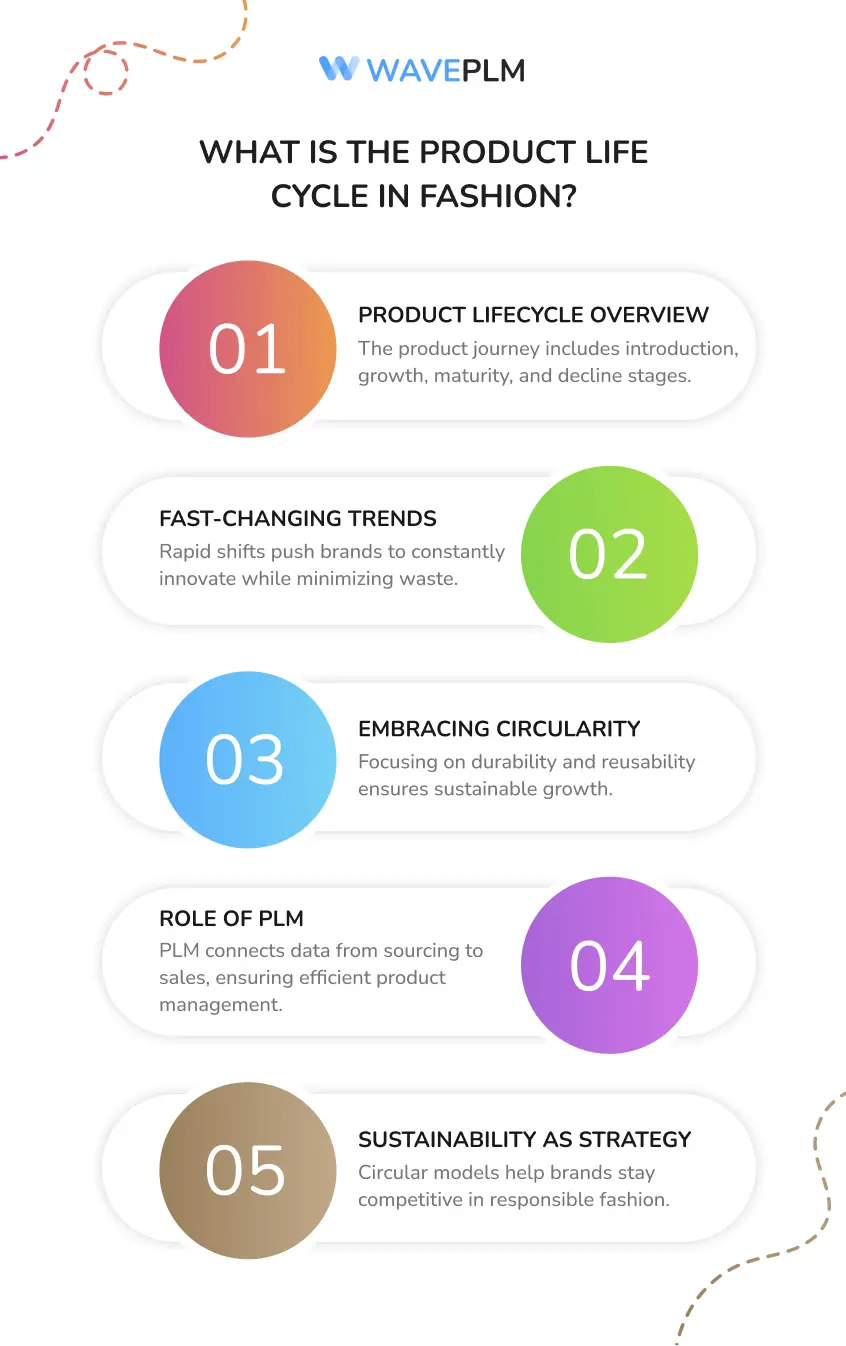
2. The Stages of a Fashion Product Life Cycle
Every fashion product passes through a predictable sequence of stages known as the product life cycle. These different stages—development, introduction, growth, maturity, and decline—are collectively referred to as the stages of the product. Understanding each life cycle stage is crucial, as it helps brands tailor strategies, allocate resources, and make informed decisions throughout the product’s journey.
|
Stage |
Description |
Sustainability Opportunities |
|---|---|---|
|
Development Stage |
The product development process begins with concept creation, fabric selection, and prototyping. Designers use market research to identify the target market and plan the product launch. |
Apply digital tools like PLM and 3D sampling to reduce waste and improve product differentiation. |
|
Introduction Stage |
The new product enters the market for the first time. Marketing professionals introduce it to customers through campaigns and retail channels. Common pricing strategies at this stage include price penetration (setting a low initial price to quickly gain market share) and price skimming (setting a high initial price to maximize margins from early adopters). Sales volume tends to be low initially, and careful management of marketing and production costs is essential to avoid financial strain. |
Use ethical marketing and transparent communication to highlight sustainable materials and manufacturing methods. |
|
Growth Stage |
This growth phase, also known as the growth stages, is marked by a rapid increase in sales volume as the product gains popularity and customer interest. |
Optimize supply chains, refine production processes, and focus on scalability without compromising quality. |
|
Maturity Stage |
The market reaches market maturity, often leading to market saturation and the saturation stage. Sales volume stabilizes as competitors enter the space and growth slows. |
Introduce upgrades or redesigns, and explore new markets or resale programs to extend the product life. |
|
Decline Stage |
This is the market decline stage, also referred to as the final stage of the product’s life cycle. Demand decreases, sales fall, and market share drops due to new trends or innovations. Managing marketing and production costs becomes critical to maintain profitability or minimize losses. |
Recycle, upcycle, or reuse materials to recover value and minimize waste. |
Insight: According to Harvard Business Review, brands that invest in understanding product life cycle stages can manage production costs more effectively while maintaining consistent brand presence across different market segments. Fashion companies that use PLM and lifecycle analytics can make data-backed decisions to identify when to invest, innovate, or pivot.
By understanding the product’s life cycle and the various product life cycles, brands can optimize revenue contributions savings and adapt their strategies at each stage. Management and marketing professionals use knowledge of the stage of the product to inform business decisions, ensuring that resources are allocated efficiently and opportunities for innovation and growth are maximized.
3. Analysis Tools for Managing the Fashion Product Life Cycle
In today’s fast-paced fashion industry, effective product life cycle management hinges on the ability to gather, analyze, and act on data at every stage of a product’s life. Analysis tools have become indispensable for brands seeking to optimize their product life cycle strategy, maximize profit margins, and stay ahead of shifting consumer preferences.
During the introduction stage, analysis tools help brands assess initial market response and fine-tune their marketing campaigns. By tracking early sales data and customer feedback, companies can quickly identify which distribution channels and marketing efforts are most effective, allowing for agile adjustments that set the stage for successful market growth.
As a product enters the growth stage, analysis tools become even more critical. Platforms like Google Analytics and social media monitoring tools provide real-time insights into customer engagement, sales trends, and market share. This data empowers brands to allocate resources efficiently, refine their marketing strategies, and capitalize on emerging opportunities in new market segments. Additionally, competitive analysis tools help brands monitor industry trends and benchmark their performance against rivals, ensuring they remain relevant during periods of rapid market growth.
When a product reaches the maturity stage, maintaining a competitive edge requires a focus on product differentiation and customer retention. Customer relationship management (CRM) software and sentiment analysis tools offer deep insights into consumer preferences and behavior, enabling brands to develop targeted marketing campaigns and introduce product features that resonate with their audience. Financial analysis tools also play a key role, helping brands monitor manufacturing costs, optimize production processes, and protect profit margins as the market approaches saturation.
In the decline stage, analysis tools assist brands in diagnosing the causes behind falling sales and shifting demand. Market research reports and trend analysis platforms reveal changes in consumer preferences and highlight new technological advancements that may be impacting the market. With this information, brands can make informed decisions about whether to revitalize an existing product, pivot to new markets, or strategically withdraw from the market to minimize losses and maximize revenue contributions.
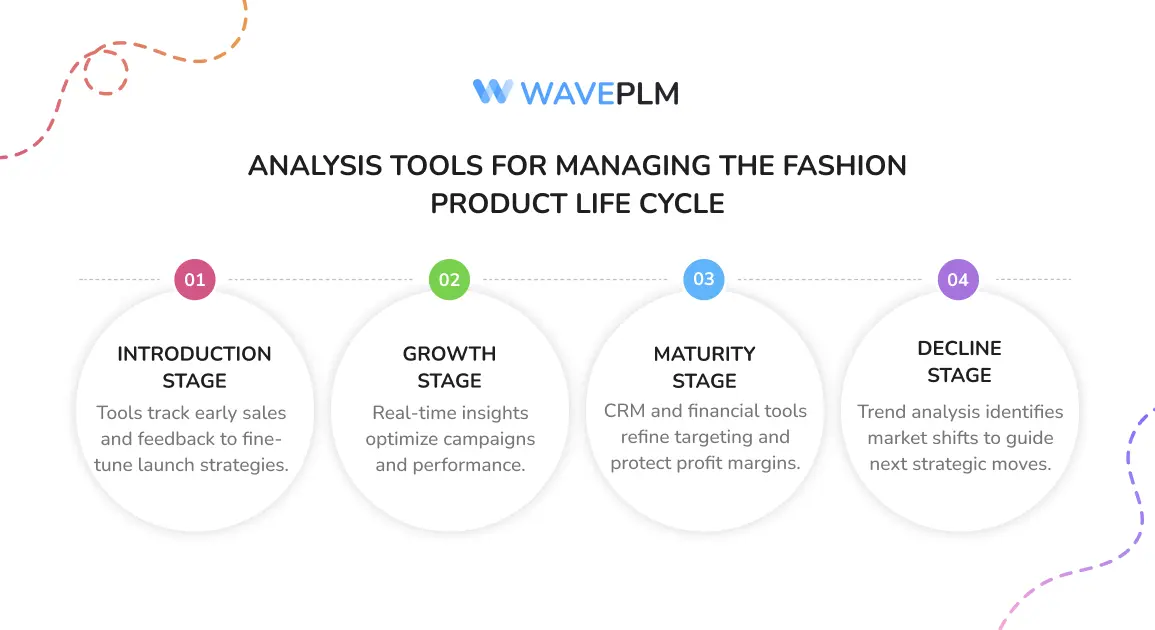
3. How Digital Systems Extend Product Lifespans
Digital tools like product lifecycle management software transform how brands plan and execute each stage of their entire product life cycle. A comprehensive software system supports collaboration among product teams, enabling them to efficiently manage and optimize the product’s lifecycle from introduction to decline. These systems offer structure and insight, helping brands anticipate the future of their collections and adjust strategies in real time.
Benefits of PLM in the Fashion Industry
- Centralized Product Data Management: PLM software creates a unified platform for all product information and streamlines business processes across departments. Designers, sourcing teams, and production managers can access accurate data anytime, ensuring decisions are based on verified insights rather than guesswork.
- End-to-End Visibility: Brands can track performance across all stages — from material sourcing to customer feedback — allowing them to adjust strategies quickly. This end-to-end visibility also improves data quality, enabling better decision-making throughout the product lifecycle.
- Optimized Collaboration: By integrating with ERP and logistics systems, PLM reduces communication gaps and delays, ensuring smoother workflows.
- Reduced Manufacturing Costs: Digital product lifecycle management reduces waste, minimizes errors, and saves both time and resources during production.
- Enhanced Repairability and Reusability: Accurate product data makes it easier to track how and when a product can be repaired, reused, or recycled.
Example: A denim brand that tracks product data through PLM can trace each fabric roll, dye lot, and production batch. When the product reaches the end-of-life stage, this data helps identify recyclable fibers and plan efficient material recovery.
In short, PLM doesn’t just manage data — it drives innovation, empowers management and marketing professionals to make informed decisions throughout the product’s lifecycle, and ensures every product decision supports the brand’s sustainability and profitability goals.
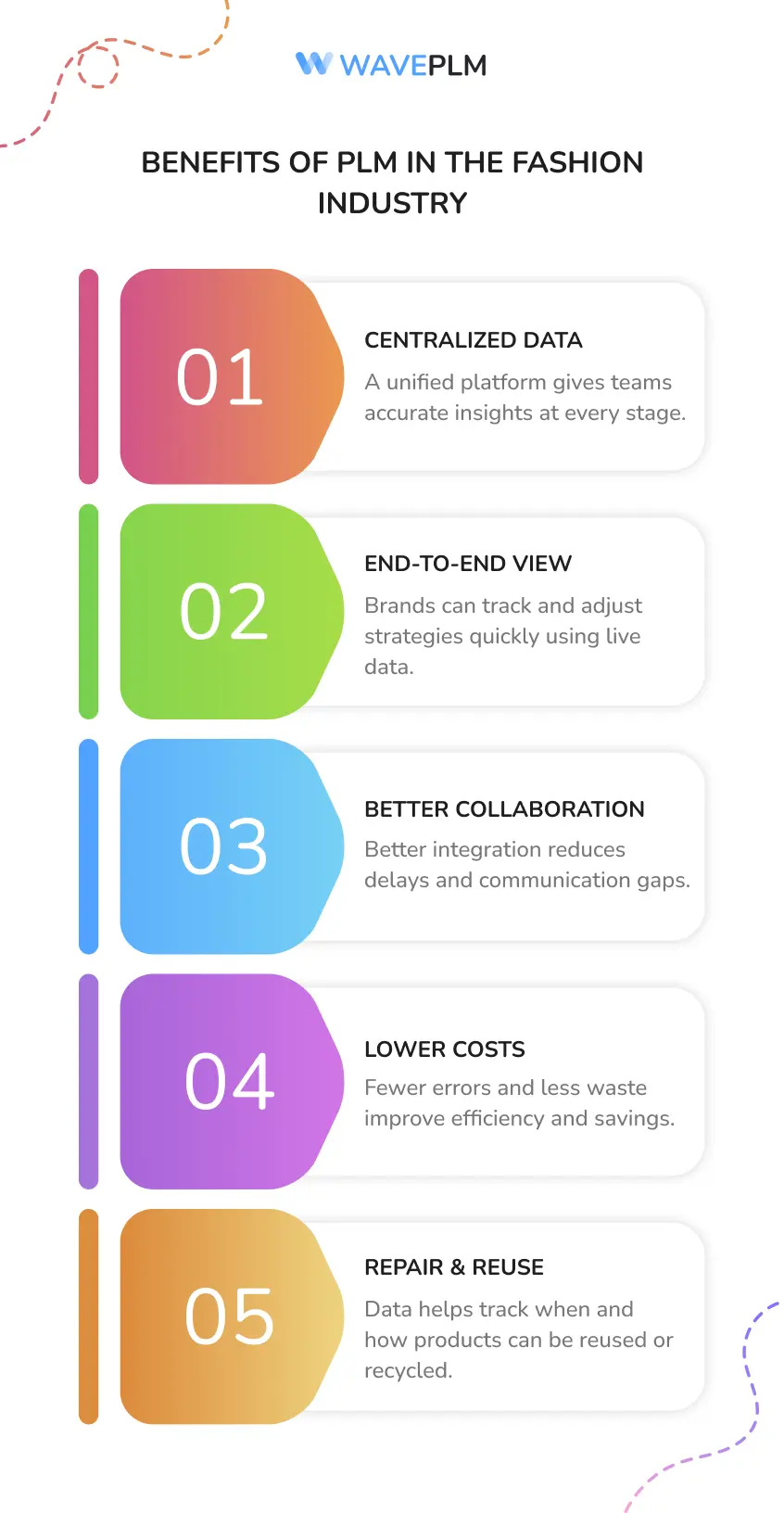
4. Circular Strategies That Redefine the Life Cycle
The concept of a circular fashion economy transforms the traditional linear model into a closed loop, where products are designed for reuse, recycling, and reinvention. Let’s explore how brands extend product lifespans using creative strategies.
1. Upcycling and Redesign
Brands reuse old stock, returns, or unsold items by transforming them into new designs. For instance, repurposing denim scraps into patchwork jackets or accessories reduces textile waste and offers consumers unique, limited-edition pieces. This approach adds value to existing products and strengthens brand identity.
2. Rental and Resale Models
Fashion rental platforms and secondhand resale markets give clothes a second life, aligning with modern consumers’ focus on sustainability. Brands can create verified resale programs that ensure authenticity and track ownership through PLM systems.
3. Recycling and Material Recovery
Advanced recycling technologies, combined with PLM data, help identify recyclable fibers and sort materials efficiently. This supports closed-loop production, where old garments become raw materials for new ones.
4. Deadstock and Limited Edition Collections
Using deadstock fabrics for limited collections minimizes overproduction and drives exclusivity. Designers can test new styles during the growth maturity and decline phases without large production runs, reducing risk and waste.
5. Customer Education and Engagement
Circularity also depends on consumers. Brands that educate customers about garment care, repair, and recycling build loyalty while extending the product’s useful life.
Together, these strategies redefine fashion’s relationship with the environment. They shift focus from constant production to mindful resource use, aligning perfectly with product lifecycle management principles.
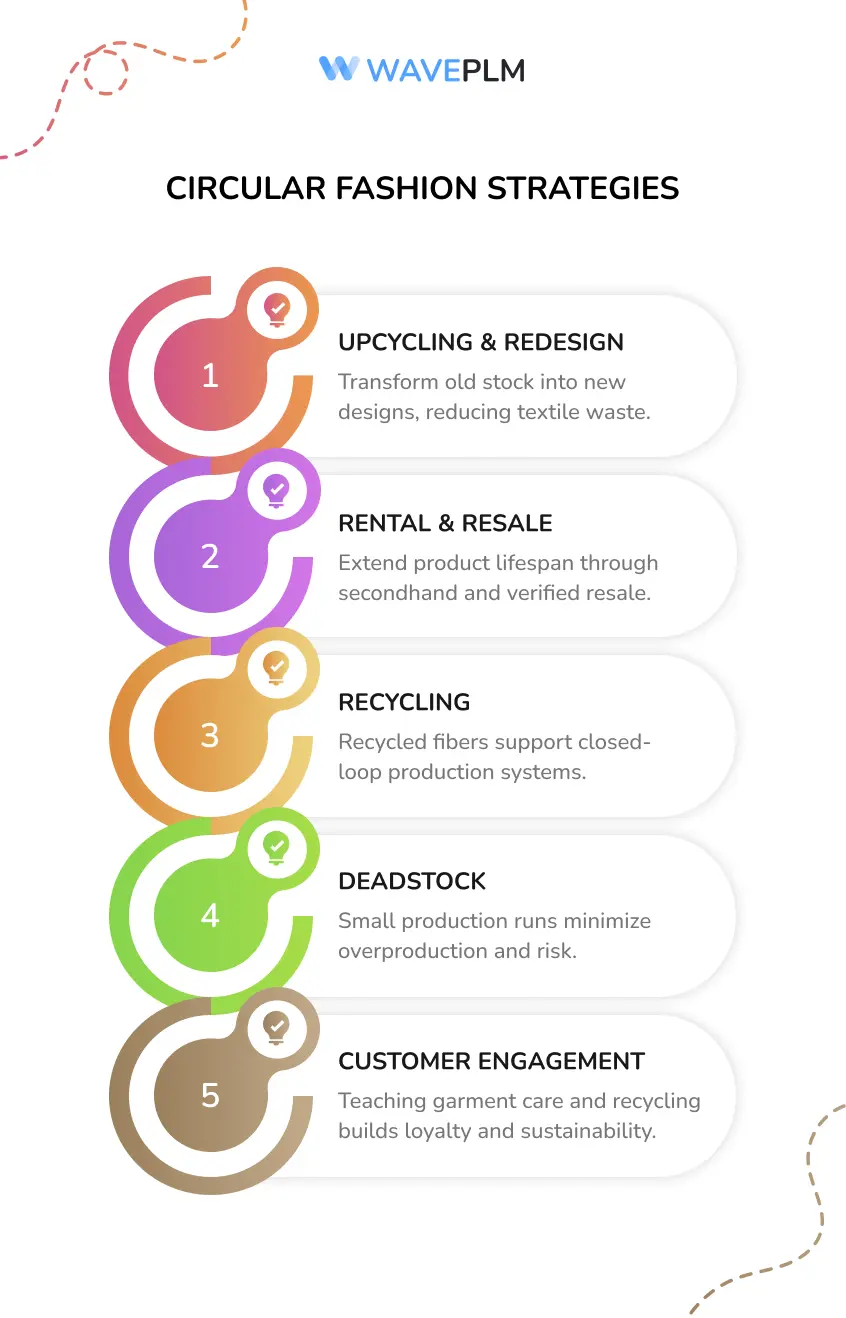
5. Future of Product Lifecycle in Fashion
The future of fashion will depend heavily on technology, data, and predictive intelligence. Brands that use AI, analytics, and digital twins can understand their customers better, forecast demand, and manage each product’s journey more precisely. Leveraging industry insights will also be crucial for brands to stay ahead in the evolving fashion landscape.
To succeed, brands must not only embrace new technologies but also develop a flexible marketing plan to adapt to rapid changes in technology and consumer behavior.
Emerging Technologies and Their Impact
- AI and Market Research: AI tools analyze consumer behavior, predict market growth stage transitions, and help determine optimal timing for product launches.
- Digital Twins: Virtual replicas simulate how garments will perform in real-world use, predicting wear, tear, and durability. This supports design improvements before physical production.
- Virtual Sampling and 3D Design: Virtual samples eliminate the need for multiple prototypes, reducing material waste and manufacturing costs.
- Smart Materials and Traceability: Advanced textiles embedded with digital tags provide real-time information on a product’s origin, usage, and recyclability.
These innovations support data-driven lifecycle management and help brands move toward zero-waste production. As new technological advancements evolve, brands that combine PLM insights with AI-powered analytics will gain a competitive advantage in market maturation and customer engagement.
6. Conclusion: From Short Trends to Long-Term Value
Mastering the fashion product life cycle means understanding that success comes not just from launching new collections but from sustaining them responsibly. Each phase — from introduction to eventual decline — offers unique opportunities for innovation and brand growth.
Brands that invest in product lifecycle management tools and circular strategies transform their operations from reactive to proactive. They reduce production costs, strengthen marketing strategies, and deliver measurable sustainability results. In doing so, they not only meet customer expectations but also contribute to a healthier planet.
The fashion industry is evolving fast. Companies that adapt to this change, focus on transparency, and prioritize circularity will set new standards of excellence. Through PLM systems, data integration, and creative reuse, fashion brands can finally balance artistry with responsibility — creating a lasting legacy built on value, innovation, and sustainability.



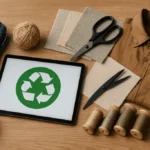

Leave a Reply